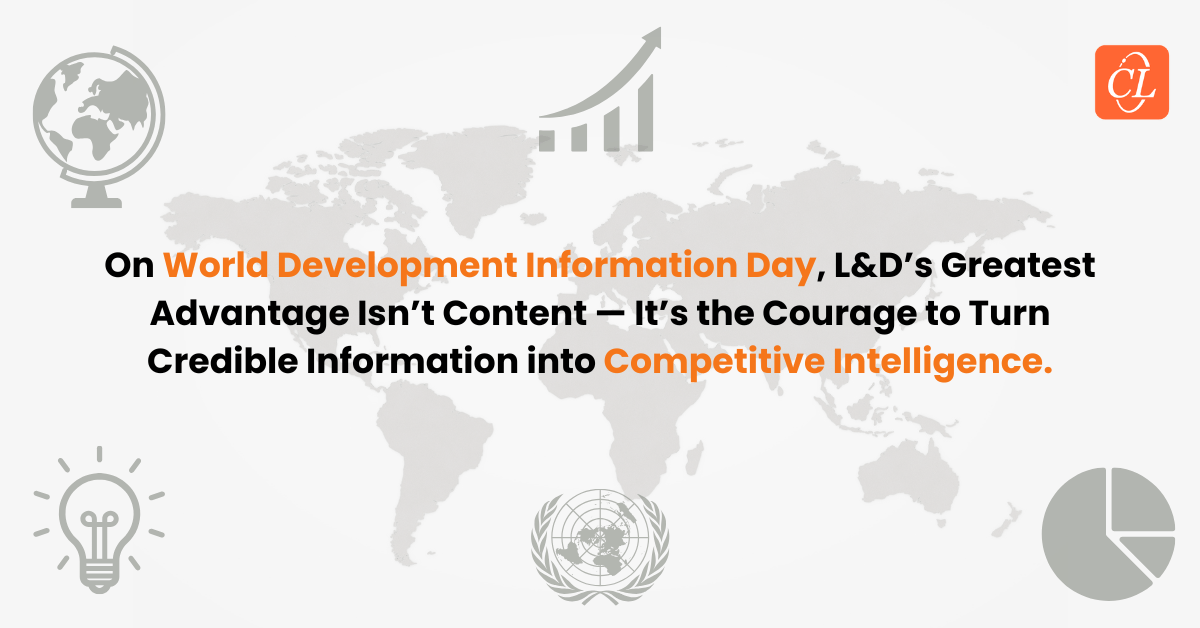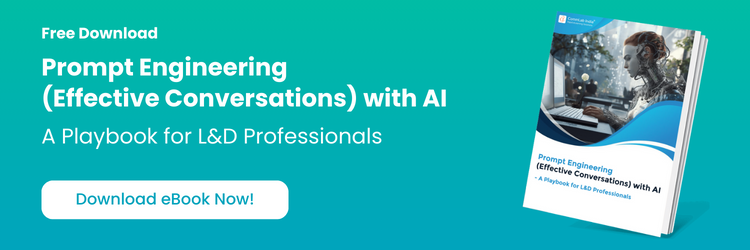
World Development Information Day: Empowering L&D Forward
Your people sell into, source from, and serve communities where regulation, technology, and social expectations shift faster than training cycles. This is the moment to convert scattered awareness into measurable skills and behaviors that customers notice, and the business can track; align leaders on one narrative; localize for real markets; make access truly inclusive; and prove on-the-job transfer with credible data. As an annual global signal of why credible information must translate into participation and progress, World Development Information Day underscores the significance of informed employees, trusted narratives, and equitable access in driving outcomes that communities value and enterprises can scale.
Download Playbook: Prompt Engineering with AI
Table Of Content
What Is the Origin and Purpose of World Development Information Day?
World Development Information Day was established by the United Nations in 1972, during the 27th session of the UN General Assembly. The date—October 24—was chosen to coincide with United Nations Day, symbolizing the close connection between global cooperation and development.
The idea for this observance stemmed from the 1970 International Development Strategy for the Second United Nations Development Decade, which aimed to raise awareness about development issues and encourage international collaboration to address them. The UN believed that effective dissemination of information about development challenges and solutions could mobilize global public opinion and spur collective action toward sustainable growth and poverty eradication.
Essentially, the day serves two intertwined purposes:
1. To draw global attention to development problems, such as inequality, economic instability, and lack of access to education and healthcare.
2. To promote the spread of information and technology, encouraging both developed and developing nations to work together for a fairer, more prosperous world.

What Is the Role of Information in Learning and Development (L&D)?
In Learning and Development, information is not just content — it’s the foundation of intelligent learning ecosystems. It drives how organizations design, deliver, and evolve learning to meet changing business and workforce needs. The modern L&D function thrives on the ability to collect, interpret, and apply information strategically, turning data into actionable insights that make learning more personalized, measurable, and aligned with performance.
Here’s how information truly shapes L&D today:
1. From Content Creation to Contextual Learning L&D teams no longer rely on static training materials. They use learner data, role-based insights, and behavioral analytics to craft contextual learning journeys. Information helps them understand what employees need to learn, why they need it, and how it connects to performance outcomes.
2. Predicting and Bridging Skill Gaps With workforce analytics and skill intelligence platforms, information helps L&D professionals anticipate emerging skill gaps before they affect productivity. This enables data-driven upskilling and reskilling strategies that keep organizations future-ready.
3. Personalizing Learning at Scale Through learning management systems (Learning Management Systems) and AI-powered platforms, information is continuously gathered—from learning preferences to engagement metrics. This allows L&D to deliver adaptive learning experiences where content evolves based on individual progress and performance.
4. Driving Learning Impact and Business Alignment Information bridges the gap between learning and results. By tracking metrics such as knowledge retention, behavioral change, and performance improvement, L&D can prove tangible business impact and continuously refine its strategy.
5. Fostering a Knowledge-Driven Culture The goal of L&D is to create a workplace where learning is ongoing and self-directed. Information fuels knowledge sharing networks, peer learning platforms, and internal knowledge hubs—ensuring that learning becomes part of everyday work, not a one-time event.
How Technology Amplifies the Power of Information in L&D?
What Tools Can Power Informed Learning This World Development Information Day?
- Learning Analytics Platforms – Use tools like Watershed or Power BI to turn learning data into actionable insights.
- Knowledge Hubs – Centralize credible content with Notion, Confluence, or Guru for easy team access.
- AI-Powered Design Tools – Create adaptive, engaging learning with Synthesia, Vyond, or Articulate Storyline 360.
- Localization & Accessibility Tools – Ensure inclusion using DeepL, ai, and CommLab India’s Multilingual Wrapper.
- Content Integrity Tools – Verify accuracy and trust with Copyleaks, Feedly, or Google Fact Check Tools.
Technology amplifies the power of information in Learning and Development (L&D) by transforming raw data into actionable learning intelligence that enhances how organizations design, deliver, and measure learning. It uses digital tools—like Learning Experience Platforms (LXPs), Artificial Intelligence (AI), analytics, and automation—to collect, process, and interpret learner data in real time. This integration of technology and information allows L&D teams to move from content creation to learning orchestration, where every piece of data informs smarter decisions and personalized experiences.
Here’s how this transformation unfolds:
1. Data as the Core of Learning Design
Technology enables L&D professionals to gather information from multiple sources—performance dashboards, skill assessments, and behavioral analytics—to design learning that directly addresses performance needs. Rather than assuming what learners need, instructional designers now rely on data-backed insights to curate relevant and impactful training.
2. Automation for Adaptive Learning
AI and automation are revolutionizing learning by continuously analyzing learner behavior to adjust pace, complexity, and content in real time. This creates truly adaptive learning environments—where information evolves with each learner’s progress, ensuring they get exactly what they need, when they need it.
And that’s just the beginning. Discover how today’s smartest L&D teams are leveraging AI to design, deliver, and personalize learning experiences like never before.
3. Analytics for Measurable Impact
Advanced analytics tools convert learner activity data into performance insights. These metrics allow L&D teams to measure ROI, identify skill gaps, and refine learning strategies with precision. Information thus shifts from being descriptive (“what happened”) to predictive (“what’s next”).
4. Semantic Video Learning Engines — A New Information Frontier
A cutting-edge innovation in 2025, semantic video learning engines use AI to understand and tag the meaning within videos. Unlike traditional video courses, these engines:
- Break down long videos into micro-concepts automatically,
Explore CommLab India’s microlearning solutions for agile, personalized, and high-impact learning experiences
- Detect when learners replay or pause to identify confusing sections,
- Recommend follow-up resources linked to the exact concept being learned.
This transforms passive video learning into an interactive, data-informed experience, where information about the learner’s engagement becomes the foundation for continuous personalization.
5. Connected Ecosystems for Continuous Learning
Modern learning technologies integrate with HR systems, CRMs, and productivity platforms, creating a unified learning ecosystem. This ecosystem ensures that learning information flows seamlessly across departments—linking employee development to business outcomes like productivity, innovation, and retention.
Yet, even as these intelligent systems make learning more connected, many employees still struggle to keep up.
According to Forbes (2025 Report), development information is more essential than ever, yet 41% of employees say they have no time to learn.
This gap highlights why modern L&D strategies must focus not only on building access to information, but also on enabling time, relevance, and motivation to turn that information into action.
What Are the Emerging Frontiers of Information in Learning and Development (L&D)?
The emerging frontiers of information in L&D refer to the new ways organizations collect, interpret, and apply data to create smarter, more adaptive, and ethically responsible learning experiences. These frontiers go beyond traditional content delivery — they redefine how information fuels decisions, personalizes learning, and proves business impact.
In today’s dynamic business landscape, information has become a strategic capability, not just a resource. The ideals of World Development Information Day—equitable access, accuracy, and responsible use of information—are now shaping how organizations design and deliver learning for a fast-changing world.
Here’s how information is transforming the future of L&D:
1. Cognitive and Behavioral Insights Advances in cognitive science and analytics help L&D teams understand how employees absorb, retain, and apply information. Learning design is increasingly guided by attention data, engagement metrics, and behavioral cues—making training more intuitive and scientifically effective.
2. Ensuring Information Integrity With AI in L&D becoming mainstream, verifying the credibility of learning material is crucial. L&D teams are implementing content validation systems to ensure all resources are current, unbiased, and trustworthy, echoing the mission of World Development Information Day to promote reliable information.

3. Predictive and Proactive Learning Analytics now enable organizations to predict emerging skill gaps before they affect performance. This shift from reactive to proactive learning empowers L&D to align training with future business needs.
4. Unified Learning Data Ecosystems Through tools like Experience API (xAPI) and Learning Record Stores (LRSs), organizations are connecting learning data across platforms. This provides a complete view of how employees learn formally, socially, and on the job—turning scattered data into actionable insight.
In a Nutshell
In an era where every click generates data and every decision demand insight, the true differentiator isn’t access to information — it’s the ability to translate it into learning that changes behavior and drives progress. That’s the spirit of World Development Information Day and the future of Learning and Development alike: informed people creating informed organizations. This eBook reveals how AI goes beyond being a technological advantage — it becomes a creative ally, empowering L&D professionals to design learning experiences rooted in purpose, ethics, and human insight, with 100+ powerful prompts to guide every step.
Learn how to use AI not just as a tool, but as a creative partner in designing impactful learning experiences — download now.





